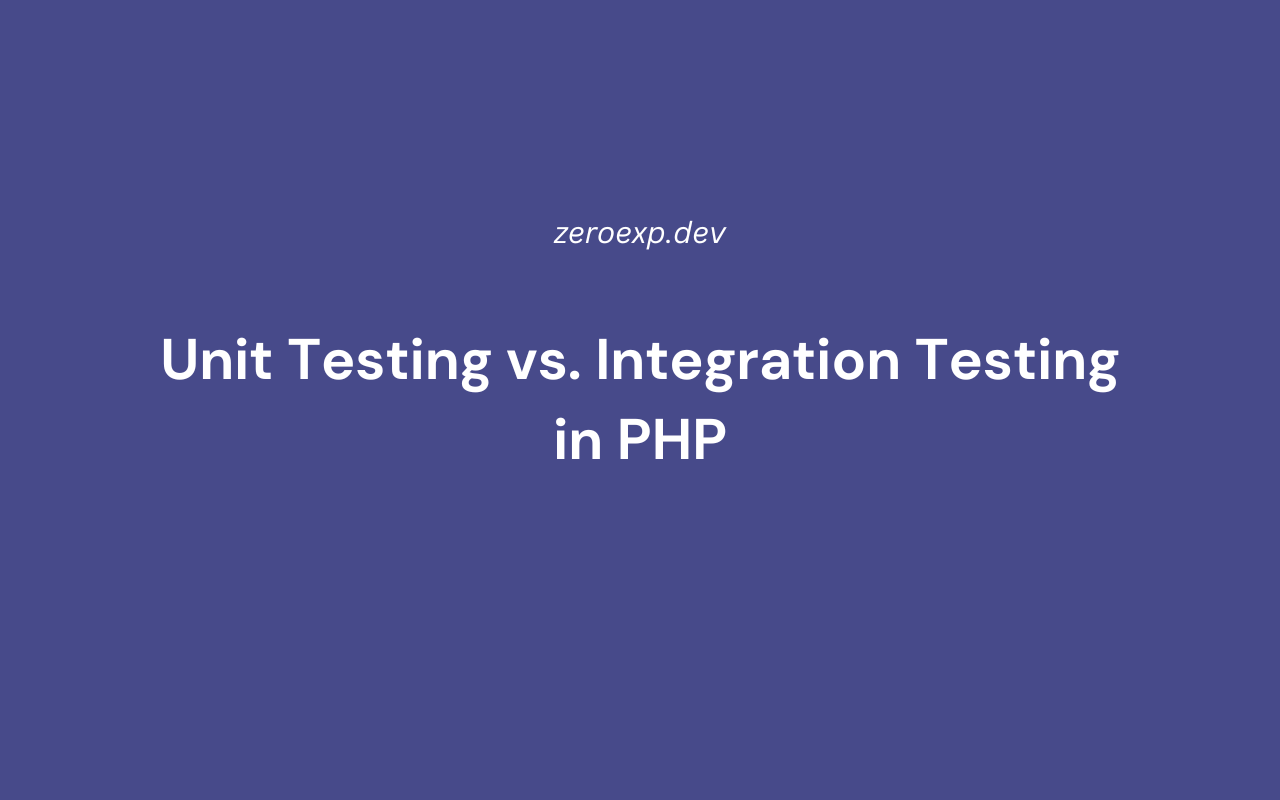Understand the key differences between unit testing and integration testing in PHP. Learn when to use each type for better software quality and reliability.
Introduction
Software testing is essential for building stable and reliable applications. Two fundamental testing types in PHP development are unit testing and integration testing.
While both are crucial, they serve different purposes:
- Unit Testing verifies individual functions or methods in isolation.
- Integration Testing checks how different modules work together.
By understanding the difference, you can:
- Choose the right testing strategy for your project
- Improve test coverage and prevent bugs
- Write efficient and maintainable test cases
This guide covers:
- The key differences between unit and integration testing
- When to use each type
- Writing PHPUnit tests for both unit and integration scenarios
- Best practices for combining both approaches
1. What is Unit Testing?
Unit testing focuses on testing individual components of an application, such as functions, classes, or methods. It ensures that each unit works as expected in isolation.
Characteristics of Unit Tests:
✅ Fast execution – No external dependencies like databases or APIs.
✅ Isolated testing – Only one function or method is tested at a time.
✅ Mocking dependencies – Uses fake objects to replace real services.
✅ Easy debugging – If a test fails, it points directly to a specific issue.
Example: Unit Testing a Calculator Class
use PHPUnit\Framework\TestCase;
use App\Calculator;
class CalculatorTest extends TestCase
{
public function testAddition()
{
$calculator = new Calculator();
$result = $calculator->add(2, 3);
$this->assertEquals(5, $result);
}
}
Why Use Unit Tests?
- Ensures small pieces of code work correctly.
- Detects bugs early in development.
- Encourages modular and maintainable code.
2. What is Integration Testing?
Integration testing verifies that multiple components work together as expected. It tests how classes, databases, APIs, and other services interact.
Characteristics of Integration Tests:
✅ Tests real-world scenarios – Simulates user interactions.
✅ Involves multiple components – Checks how modules integrate.
✅ Uses actual dependencies – No mocks; tests with real databases or APIs.
✅ Longer execution time – More setup required than unit tests.
Example: Integration Test for a User Registration Flow
use PHPUnit\Framework\TestCase;
use App\UserService;
use App\Database;
class UserIntegrationTest extends TestCase
{
protected $db;
protected $userService;
protected function setUp(): void
{
$this->db = new Database(); // Real database connection
$this->userService = new UserService($this->db);
}
public function testUserRegistration()
{
$user = $this->userService->registerUser('john@example.com', 'securepassword');
$this->assertNotNull($user->id);
$this->assertEquals('john@example.com', $user->email);
}
}
Why Use Integration Tests?
- Verifies real interactions between components.
- Identifies issues with database connections, APIs, and services.
- Ensures the system functions as a whole.
3. Key Differences Between Unit Testing and Integration Testing
| Feature | Unit Testing | Integration Testing |
|---|---|---|
| Scope | Tests individual methods or functions | Tests multiple components working together |
| Dependencies | No external dependencies (uses mocks) | Uses real services (databases, APIs, etc.) |
| Speed | Fast (milliseconds) | Slower (seconds or more) |
| Failure Detection | Easily identifies the faulty function | Harder to trace specific failures |
| Use Case | Checks correctness of a single function | Ensures overall system functionality |
4. When to Use Unit Tests vs. Integration Tests
Use Unit Tests When:
✅ You need fast, isolated tests.
✅ Testing pure functions, business logic, or utility methods.
✅ Verifying that a function produces the correct output.
✅ Ensuring new code does not break existing logic.
Use Integration Tests When:
✅ Checking how different modules interact.
✅ Testing database operations, external APIs, or authentication flows.
✅ Verifying end-to-end user workflows.
✅ Ensuring components work correctly together in real environments.
Example: A Balanced Testing Strategy
A well-tested PHP application should combine both unit and integration tests:
- Unit Tests ensure individual components work as expected.
- Integration Tests verify the system behaves correctly as a whole.
5. Using PHPUnit for Both Unit and Integration Testing
Unit Test Example (Mocking a Dependency)
use PHPUnit\Framework\TestCase;
use App\UserService;
use App\UserRepository;
use Mockery;
class UserServiceTest extends TestCase
{
public function testGetUserById()
{
$mockRepo = Mockery::mock(UserRepository::class);
$mockRepo->shouldReceive('findUserById')
->with(1)
->andReturn(['id' => 1, 'email' => 'user@example.com']);
$userService = new UserService($mockRepo);
$user = $userService->getUserById(1);
$this->assertEquals('user@example.com', $user['email']);
}
protected function tearDown(): void
{
Mockery::close();
}
}
- Uses Mockery to replace the real database dependency.
- Ensures the
getUserById()function works in isolation.
Integration Test Example (Real Database Connection)
use PHPUnit\Framework\TestCase;
use App\UserService;
use App\Database;
class UserIntegrationTest extends TestCase
{
protected $db;
protected $userService;
protected function setUp(): void
{
$this->db = new Database(); // Real DB connection
$this->userService = new UserService($this->db);
}
public function testUserCanRegisterAndRetrieveData()
{
$this->userService->registerUser('alice@example.com', 'securepassword');
$user = $this->userService->getUserByEmail('alice@example.com');
$this->assertNotNull($user);
$this->assertEquals('alice@example.com', $user->email);
}
}
- Uses a real database connection to test the full registration process.
- Ensures that the database correctly stores and retrieves user data.
6. Best Practices for Combining Unit and Integration Testing
- Write more unit tests than integration tests (they should run quickly).
- Use mocks for dependencies in unit tests to avoid external interactions.
- Run integration tests less frequently, but cover critical workflows.
- Automate tests using CI/CD to catch issues early.
- Separate test environments for unit tests (mocked) and integration tests (real data).
Conclusion
Both unit testing and integration testing play essential roles in PHP development.
This guide covered:
- The differences between unit and integration testing
- When to use each type of test
- Writing PHPUnit tests for both unit and integration scenarios
- Best practices for maintaining a balanced testing strategy
By combining both approaches, you can ensure that individual components work correctly while verifying the entire system functions as expected.
